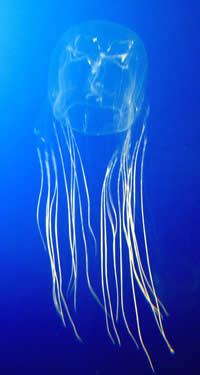
Jellyfish sting
What are jellyfish?
Symptoms of jellyfish sting
Remedies / cures / treatment for jellyfish sting
What are jellyfish?
Jellyfish are free-swimming marine animals with a gelatinous umbrella-shaped bell and trailing tentacles. The bell pulsates for locomotion, while their stinging tentacles are used to capture prey.
Jellyfish are found in every ocean at depths ranging from the surface to the deepest trenches. They are often found along beaches, and can also thrive in freshwater rivers and lakes.

Jellyfish tentacles are covered with small barbed venomous stingers. The stingers can penetrate the skin and release toxins.
Symptoms of jellyfish sting
Many jellyfish have no apparent sting on human skin, others cause a slight burning sensation for a few seconds. Most jellyfish stings are just annoying little stings that go away within an hour. Bluebottles and other stinging jellyfish can cause a painful raised red welt that can remain for hours or days. A few jellyfish such as some species of the box jellyfish in the tropical northern parts of Australia are highly venomous, and without emergency treatment can result in death within an hour.
The venom of the most dangerous species of jellyfish can enter the bloodstream causing symptoms such as difficulty breathing, muscle spasms, racing heart or even heart failure, vomiting, fever and joint inflammation. If stung by a box jellyfish in Northern Australia, urgent medical attention is required.
Remedies / cures / treatment for jellyfish sting
There are several traditional home remedies which quickly relieve the pain and inflammation of a jellyfish sting. The most important thing is to act fast.
If you use any of these remedies, please come back next week (or whenever you have an outcome) and let us know about your experience. Please leave a comment as many people are interested.
See details of remedies recommended by Grow Youthful visitors, and their experience with them.
- Urine - pee on your sting. This will counteract the venom injected by the stinging barbs. This is a traditional and effective remedy used for centuries, and is widely used by surfers. It is always quickly and easily available. Unfortunately on a crowded beach many people are reluctant to use this remedy, but in a painful emergency please use it as an immediate treatment.
- Vinegar. The most commonly used treatment is vinegar (any kind of strong vinegar). Splash undiluted vinegar on the skin as soon as possible. Many Australian lifeguards keep a bottle of vinegar nearby. Vinegar helps break down the toxins injected by the stinging barbs. Use the vinegar immediately after the sting, because its purpose is to stop the barbs from injecting venom. After cleaning the skin, it is of little use.
- Rinsing off. Another remedy is to gently stroke the sting with a towel or soft leather or rubber glove (not a bare hand which can receive the barbs). Be careful with this treatment, because sometimes it will cause the embedded barbs to fire off their venom rather than removing the barbs. If you are going to use vinegar, apply vinegar BEFORE rinsing off. Rinse with hot water (hotter than bathwater) to remove any loose barbs. Use ocean or river water if hot water is not immediately available.
- Heat breaks down jellyfish venom. Apply heat to a jellyfish sting using a heat pad or a hot cloth. Keep it as hot as you can comfortably stand without burning the skin. Keep applying the heat for 30 minutes.
- Gum turpentine applied to the skin will soothe the sting area.
- Cinnamon. Shake cinnamon powder directly on the sting. It relieves pain, prevents blistering, and speeds healing.
- Cold treatment. Lastly, during the healing hours or days later, use an ice pack to relieve pain, redness, swelling and itching. Sometimes alternating with warm or hot water is effective.
